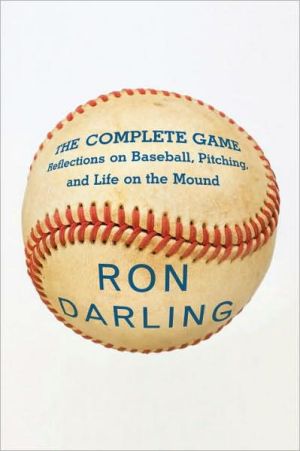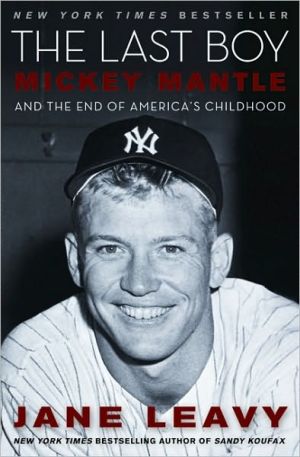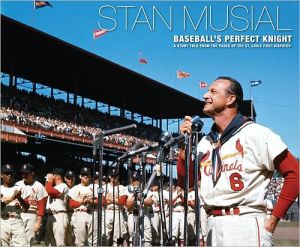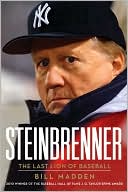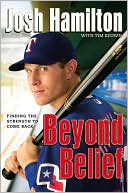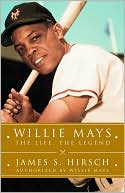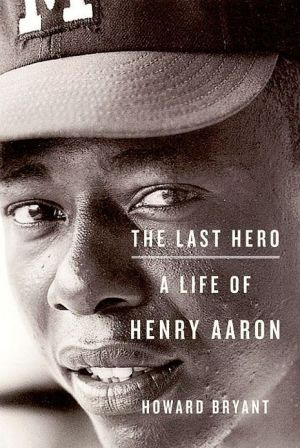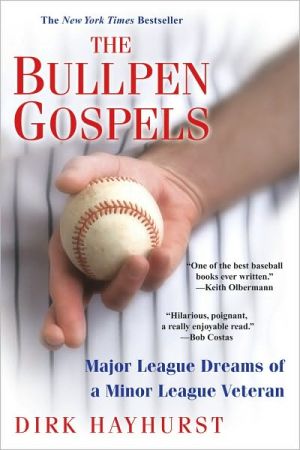The Complete Game: Reflections on Baseball, Pitching, and Life on the Mound
Ron Darling has been beloved by Mets fans since he helped his team win the 1986 World Series. Today he is considered one of the most articulate and insightful broadcasters in baseball, bringing the game to life in ways that few can match. Now he gives us an engaging, sophisticated, practical, and philosophical exploration of the art, strategy, and psychology of pitching.\ Darling takes us inside the pitcher’s mind, illuminating the subtler aspects of the game and providing a deeper...
Search in google:
Ron Darling has been beloved by Mets fans since he helped his team win the 1986 World Series. Today he is considered one of the most articulate and insightful broadcasters in baseball, bringing the game to life in ways that few can match. Now he gives us an engaging, sophisticated, practical, and philosophical exploration of the art, strategy, and psychology of pitching.Darling takes us inside the pitcher’s mind, illuminating the subtler aspects of the game and providing a deeper appreciation of what happens on the field. He explains why the position of pitcher is uniquely strategic and complex and explores the various tactics a pitcher uses in different scenarios, including the countless factors in deciding what to throw and how he bounces back from a tough inning. Throughout, we get a glimpse of what it feels like to stand alone on the mound, the center of attention for tens of thousands of fans.While there are technical books on pitching, there is no other book that examines the position in such compelling depth as The Complete Game. Filled with captivating, real-life anecdotes, it will do for pitching what Ted Williams’s The Science of Hitting did for batting—and it will be an essential book for every fan and aspiring player. The New York Times - Bruce Handy …a thoughtful and lively new book about the art, craft and business of [Darling's] trade. It's a nuts-and-bolts kind of baseball book—a pitcher's answer to Ted Williams's classic, The Science of Hitting…but it is also, in part, a memoir. A workplace memoir. It tells us not only how Darling pitched, but what being a baseball player felt like to him, and what the game meant to him.
\ The Complete Game\ \ Reflections on Baseball, Pitching, and Life on the Mound \ \ \ \ By Ron Darling \ Knopf \ Copyright © 2009 \ \ Ron Darling\ All right reserved.\ \ \ ISBN: 9780307269843 \ \ \ \ Chapter 1\ \ Pregame\ \ \ Let’s Get It Right Today\ \ \ Give me the damn ball!”\ \ That’s been the rallying cry of major league pitchers since the turn of the last century. The ball. The pill. The rock. Call it what you want, it’s the only equipment we need—our badge of honor, our point of pride. It’s basic, as weapons go: a rounded piece of cushioned cork layered with a fine coating of rubber cement and wrapped in a tight winding of gray and tan wools and a thin poly-cotton thread. Then, another fine coating of rubber cement and two strips of cowhide, bound together with eighty-eight inches of waxed red thread— hand-sewn in the small farming village of Turrialba, Costa Rica, with 108 stitches.\ \ But, of course, it’s not only about the ball. It’s about the act and art of throwing it, and the responsibility that goes with the privilege of doing so for a major league baseball team. For most of us who have taken the pitcher’s mound at the professional level, it’s the weight of carrying the fortunes of your teammates, the sweet burden of being on point, that sets our role apart. If we don’t execute, there’s no hiding it out there on that mound.\ \ Everyone who plays a sport likes to think he or she is pivotal, butwith pitchers this is not an arrogant or self-aggrandizing view. The game rests on our shoulders. We stand apart from our teammates and set the tone. All eyes are on us. The game is in our hands. The hopes of our teammates are pinned to our chest. Sure, the outcome of any one game might turn on a remarkable effort in the field, a mighty swing of the bat, a gutsy play on the bases, but everything that happens on a ball field—everything!—flows in some way through the pitcher. It has every damn thing to do with us. That’s how we feel, and the reason we feel this way is because it’s been drummed into us over countless starts, countless innings, countless pitches with the game on the line.\ \ Tom Seaver, one of the greatest pitchers ever to take the mound, and certainly the greatest to do so in a New York Mets uniform, had a cutting way with words. If he liked you, he was one of the most generous souls in the game. If he didn’t ... well, not so much. We played together, briefly, in 1983, when I joined the big club for a late-season cameo. It was Tom’s second tour with the Mets, and he was cast as a conquering hero, a favorite son turned elder statesman. He had a not-so-flattering nickname for the Mets trainer, “Fifty-Fifty”; I couldn’t figure why. After I’d been in the bigs for a couple weeks, I got up the courage to ask Tom how he came up with the name.\ \ “He’s not the best trainer, kid,” said Tom, who himself was known as “the Franchise.” (How’s that for a nickname to confirm my point?) “And he’s not the worst. He doesn’t help you, he doesn’t hurt you. Fifty-Fifty.”\ \ I’ve thought about that moniker a lot over the years, and early on I hoped it never applied to me as a ballplayer, affectionately or otherwise. Over time, however, I realized there was no avoiding the tag. Sometimes you justify the faith your teammates place in you, and sometimes you don’t. If you come through more often than not, you’re doing okay. And yet, in success and in struggle, getting the ball on game day has to be the greatest rush in professional sports. The game acknowledges this, in its own way. There’s a certain amount of ceremony to the “anointing” or assigning of pitching duties, like a transfer of power. It used to be that pitchers knew they were getting a start only when they arrived at their locker to find that day’s pristine game ball sitting in their glove. The first time I heard about that, I was already in the bigs, and it struck me as a fitting tradition: you come to the ballpark; you find the ball in your locker; you understand it’s on you. That particular baseball ritual is gone, but the symbolism holds. You can see it in the way an entire team stands back in deference to the particulars of its starting pitcher. You can see it in the stony silence position players offer their pitcher while he’s throwing a gem—or a dud. You can see it in the way a manager waits on the mound to place the ball in the hands of a reliever after a pitching change. He strips one pitcher of the honor and delivers it to the next, sending one man to the showers while his successor takes the hill. The sword is passed, and we’re entrusted with the fate of our franchise—for that one day, or even that one batter, at least until we fall short.\ \ A starting pitcher, on his day, is a man alone. You’re totally ignored by your teammates. You feel it the moment you get to the ballpark, and it runs through the entire game. There are exceptions: some pitchers are nervous and like to kid around, to relax; some pitchers reach out to their teammates and engage them in conversation, about the game or something else. But most pitchers are off on their own, lost in thought, making ready. They’re looking for that zone, that tunnel, that place of calm and quiet that lets them get their head around the game, while their teammates hang back warily, afraid to encroach.\ \ It’s a special, certain thrill to head out to the ballpark knowing the game is yours, to do with what you will. For my family, it was somewhat less thrilling. I’d get a little moody as game day approached. On the morning of a game, it’s possible I even lapsed into surliness. I was something of a bear, I was told, and my game- day habits reflected this. I would not be crossed or told what to do. For night games, I took my lunch at noon, because I wanted to be good and hungry and in an even fouler mood when game time rolled around. Lunch was always the same: steak, mashed potatoes, and peas. (Note: try finding good peas in Cincinnati.) All day long, I drank plenty of water—more or less, depending on the weather. (Another note: there wasn’t enough water on the planet to keep a pitcher hydrated on the St. Louis turf, middle of August, when temperatures ran to 130 degrees.) There was also a touch of cold sweats and nausea.\ \ Game days at Shea were a particular adventure. On the road, I could hide in the shadows of the team bus, but at home I was on my own. You’d never know what might set me off. Early on in my career, I was the guy you didn’t want to talk to on the 7 train out to Flushing—not quite De Niro in Taxi Driver, but close. Later, when the fans started to recognize me and the subway was no longer an option, I was the guy you didn’t want to piss off on the Grand Central Parkway—the guy who could claim road rage as an essential occupational tool.\ \ Leave me alone. That’s the message I put out to the world on days I was due to pitch. Even to my wife and kids, the message was much the same: leave me alone so I can do my thing and prepare for battle.\ \ People who know me will tell you I’m basically a good person. I’m kind to animals, and kids, and little old ladies. I hold the door open for strangers. But on game day, I was someone else, someone I didn’t recognize—someone I didn’t even necessarily like. Understand, I didn’t will myself into a sour, angry mood; it just happened, and it happened for a reason. I was on a knife edge. It all fell to me— that’s how I approached my time on the mound, and that approach inevitably colored my personality. I imagined I was a boxer, getting ready to step into the ring. A matador preparing to face down a charging bull. A fighter pilot embarking on a do-or-die mission.\ \ God help the poor manager or pitching coach who had to administer last-minute instructions. Mel Stottlemyre, the Mets pitching coach and great father figure to all of us young pitchers on those talented Mets teams of the late 1980s, knew how to handle me on game days. He was careful not to set me off, but at the same time there were always a couple things he felt he needed to discuss. I rarely bit Mel’s head off, but I don’t think I ever really listened to him, either. Despite his best efforts, I never could pay attention. Between starts, sure, I let Mel have his say, and I valued his input. He made me a better pitcher. But just before a start, I didn’t want to hear it. I couldn’t hear it.\ \ Keeping up with Mel and his final analysis was like trying to read the phone book. I couldn’t focus on it. Nothing against Mel, but my mind was always someplace else. I was impatient. I hadn’t eaten. I’d angered or frustrated or otherwise alienated every poor soul who had crossed my path on the way to the stadium. I was pumped and primed. I needed a baseball in my hands. Enough already with the pregame discussions, I always thought. Enough with the nerves and the nausea. I was a bundle of raw energy, held together by one pleading thought: Just give me the damn ball. Please.\ \ It wasn’t until I was out in the bullpen going through my pregame warm-up that my pitching brain would click on. I’d ease into my first couple throws, soft tosses to the bullpen catcher, first from thirty or forty feet away, then fifty, and finally from the full pitching distance of sixty feet and six inches. Just a mindless game of catch, the kind I played on a thousand lazy afternoons as a kid, until I forced myself to pay attention to how my arm was feeling. There was no need for any more talk. Was I getting loose or was I in trouble? That’s all that mattered here in the bullpen. Was I ready? Was I on? I’d be acutely aware of every muscle in my body, every ache and pain, every tic and twitch. I could see and feel everything, and underneath the mindlessness of the routine I’d find time to consider every game- day variable: who was catching me, who was playing behind me in the field, who’d given me trouble in the opposing lineup, what I planned to eat for dinner that night, the weather.\ \ The pitching coach would stand watch. When it was Mel, he’d be motionless and quiet, until the throwing grew more intense. After that, he still didn’t say anything, but I could see from the corner of my eye that he was paying careful attention. In just a few minutes, the manager would call down to ask how I was throwing. God bless Mel. I know he must have lied to Davey Johnson on a number of occasions—but there were even more occasions when he didn’t have to lie. When my arm felt great. When I finished strong, hitting my spots, making the ball do whatever I wanted. When I felt invincible.\ \ The warm-up over, I’d begin that long, purposeful walk back to the dugout. The walk out to the bullpen may have been slow, but this return trip always had a little more urgency to it. I’d sidle past my bullpen brethren, accepting their claps on the back and their go- get-’ems like I had them coming. (None would admit it, but I’m sure a few of those well-wishers were imploring me to do well so they wouldn’t be called on to pitch me out of a jam.) I’d make my way through the bowels of the stadium, my cleats clicking against the cement floor like Morse code, the message a warning to the other team that I was really bringing it or a signal to my own guys to be on their toes. Mel would usually attempt a joke, to ease the tension, but I never thought the tension needed easing. I wanted to be on edge in order to do what I had to do. The security guards would shout out words of encouragement as I passed. (Half of them were Yankee fans, but what the hell.) On to the family room, where the next-of-Met-kin waited out the long stretch between warm-up and first pitch, and I’d chide myself for not knowing the names of my teammates’ wives and children.\ \ As I moved toward the mound—my office! my haven!—a voice switched on in my head, guiding me the rest of the way: No left turn into the clubhouse, you coward. Continue on. And I would, over the makeshift catwalk of AstroTurf remnants leading down the stairs to the dugout. At the bottom of the stairs, I’d find the other eight starting players, hastily sucking the last drags from their cigarettes. (Sorry, kids, but the players smoked in those days.) I’d ignore their initial looks of Shit, I can’t believe he’s here already and register instead their follow-up looks of C’mon, Ronnie, we need this one tonight. I’d walk past the boys and up the five short steps into the Mets dugout. At the other end, I’d spot Mel talking to the manager. I’d hope he didn’t have to lie tonight. I’d tell myself I felt pretty good, and then I’d take my seat on the dugout bench and towel off.\ \ This was always the most peaceful time of my pregame ritual. It didn’t last all that long, but I would try to lose myself in that brief moment. I’d think back to what baseball had meant to me as a kid. To all those hours playing with my brothers, my friends, my parents. To how lucky I was to wear a major league uniform. To be pitching, in just a few short moments, in front of fifty thousand fans.\ \ Soon the other starting players would join me on the bench, awaiting their cue to take the field. That cue doesn’t come from the public address announcer. It doesn’t come from one of the coaches or the umpire. It comes from the starting pitcher. Remember, it starts with us, and it ends with us. Every starting pitcher has his own cue, some version of the “Give me the damn ball!” rallying cry that opened these pages. Dwight Gooden, with his eerily quiet confidence, used to nod his head ever so slightly, as if to say, “Let’s go!” Sid Fernandez would humbly shrug his burly Hawaiian shoulders and offer a look: Hey, you want to go? \ \ Continues... \ \ \ \ \ Excerpted from The Complete Game by Ron Darling Copyright © 2009 by Ron Darling. Excerpted by permission.\ All rights reserved. No part of this excerpt may be reproduced or reprinted without permission in writing from the publisher.\ Excerpts are provided by Dial-A-Book Inc. solely for the personal use of visitors to this web site.\ \
\ Bruce Handy…a thoughtful and lively new book about the art, craft and business of [Darling's] trade. It's a nuts-and-bolts kind of baseball book—a pitcher's answer to Ted Williams's classic, The Science of Hitting…but it is also, in part, a memoir. A workplace memoir. It tells us not only how Darling pitched, but what being a baseball player felt like to him, and what the game meant to him.\ —The New York Times\ \ \ \ \ Library JournalAs any baseball fan can attest, ex-ballplayers who do analysis for game broadcasts remember every play of every game they were ever in. Darling is a perfect example, and here he serves up his keen recollections in a finely shaped memoir with the game-and the task of pitching-at its core. Nine chapters are each named for their respective inning: Darling recalls in detail a game he pitched in which that particular inning served as a kind of crucible. With plenty of anecdotes and asides offered along the way, this is a superior book, highly recommended for all baseball collections.\ \ —Margaret Heilbrun, Gilles Renaud\ \ \ Kirkus ReviewsThe former All-Star hurler for the New York Mets, now a baseball analyst for TBS, reflects on the profession and psychology of pitching as exemplified in his career..Is there a trite expression not found in Darling's prose? Enshrined here: "a ball game can turn on a dime," "I had some butterflies" and myriad others. Granted, it's somewhat effective to organize the text into nine "innings," plus pregame, warm-up, extra innings and postgame. Each inning/chapter centers on an actual game the author either played or watched, which allows him to ruminate on a pitcher's strategies in early, mid-game and late-game situations. Darling makes some mildly interesting comments about the craft of pitching (why he couldn't throw a slider) and his mound behavior (what he did when someone hit a home run; how he felt when the pitching coach strolled out). He also offers encomiums for former teammates Gary Carter and Jamie Quirk, coach Dave Duncan and manager Davey Johnson. He writes affectingly of his realization that his family had been having a life of its own while he was off playing and movingly describes his emotions when he reached the end of his Mets tenure, as well as his career-sunset years with the Oakland Athletics. It's evident that the author watched a lot of video; he often provides a pitch-by-pitch account of key moments in games long past. Occasionally, a felicitous phrase elbows its way through the crowd of clichés. Near the end, for example, Darling mentions baseball's "beautiful cruelty"—too bad he tries to slip the same pitch by us again 18 pages later..Will certainly appeal to devoted Mets and Darling fans, but few others..First printing of 100,000. Author tour to Atlanta,Baltimore, Boston, New York, Philadelphia, Phoenix, Pittsburgh, San Diego, San Francisco, St. Louis, Washington, D.C.\ \
